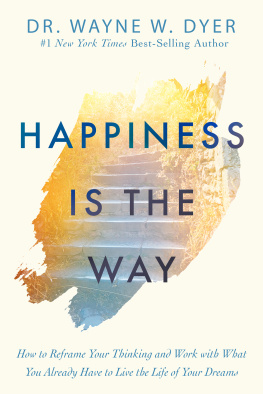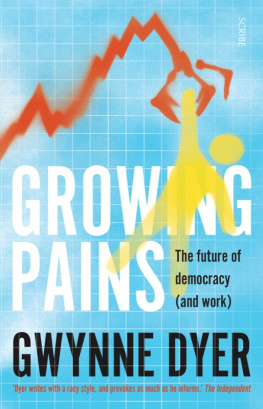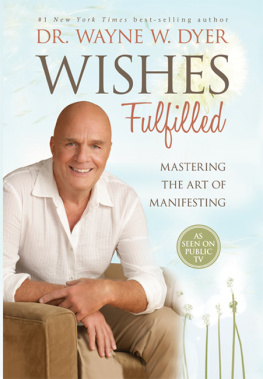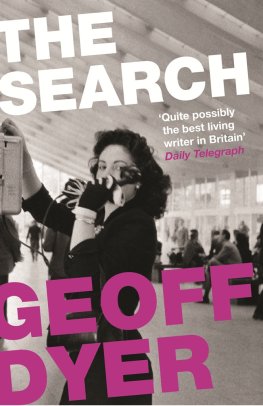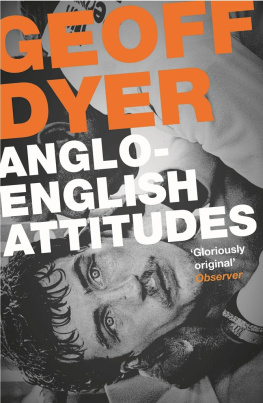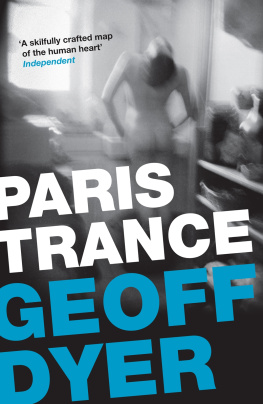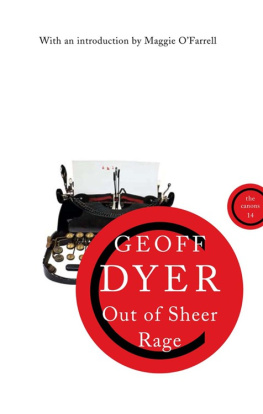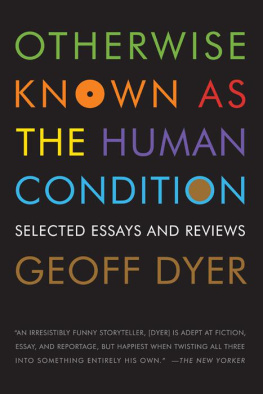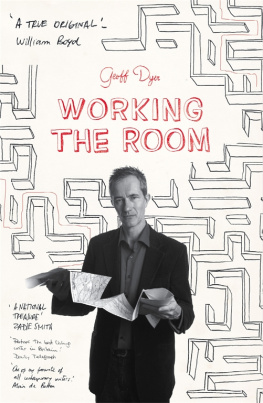BUT BEAUTIFUL
Geoff Dyer is the author of four novels and eight non-fiction books. Dyer has won the Somerset Maugham Prize, the Bollinger Everyman Wodehouse Prize for Comic Fiction, a National Book Critics Circle Award, a Lannan Literary Award, the International Centre of Photographys 2006 Infinity Award for writing on photography and the American Academy of Arts and Letters E.M. Forster Award. In 2009 he was named GQs Writer of the Year. He lives in London.
Also by the author
Zona
Working the Room
Jeff in Venice, Death in Varanasi
The Ongoing Moment
Yoga For People Who Cant Be Bothered To Do It
Anglo-English Attitudes
Paris Trance
Out of Sheer Rage
The Missing of the Somme
The Search
The Colour of Memory
Ways of Telling: The Work of John Berger

This paperback edition published in Great Britain in 2012 by Canongate Books Ltd, 14 High Street, Edinburgh EH1 1TE
www.canongate.tv
Copyright Geoff Dyer, 1991, 1996
The moral right of the author has been asserted
First published in the United States in 1996 by North Point Press, a division of Farrar, Strauss and Giroux
First published in Great Britain in slightly different form in 1991 by Jonathan Cape Ltd
Pages had their origin in a short script commissioned by Channel 4 on the theme of seduction. A few paragraphs of this book first appeared in very different form in the Guardian and the Independent.
Title-page photograph 1996 by Milton J. Hinton
Authors note: This Canongate edition follows the text of the 1996 American edition, which is slightly different from that of the original 1991 English edition.
British Library Cataloguing-in-Publication Data
A catalogue record for this book is available on request from the British Library
ISBN 978 0 85786 402 4
eISBN 978 0 85786 335 5
Typeset in Goudy Old Style by Palimpsest Book Production Ltd, Falkirk, Stirlingshire
This digital edition first published in 2012 by Canongate Books
For John Berger
PREFACE
When I began writing this book I was unsure of the form it should take. This was a great advantage since it meant I had to improvise and so, from the start, the writing was animated by the defining characteristic of its subject.
Before long I found I had moved away from anything like conventional criticism. The metaphors and similes on which I relied to evoke what I thought was happening in the music came to seem increasingly inadequate. Moreover, since even the briefest simile introduces a hint of the fictive, it wasnt long before these metaphors were expanding themselves into episodes and scenes. As I invented dialogue and action, so what was emerging came more and more to resemble fiction. At the same time, though, these scenes were still intended as commentary either on a piece of music or on the particular qualities of a musician. What follows, then, is as much imaginative criticism as fiction.
Many scenes have their origin in well-known or even legendary episodes: Chet Baker getting his teeth knocked out, for example. These episodes are part of a common repertory of anecdote and information standards, in other words, and I do my own versions of them, stating the identifying facts more or less briefly and then improvising around them, departing from them completely in some cases. This may mean being less than faithful to the truth but, once again, it keeps faith with the improvisational prerogatives of the form. Some episodes do not even have their origins in fact: these wholly invented scenes can be seen as original compositions (though they sometimes contain quotations from the musicians concerned). For a time I worried about whether I should indicate where I had someone in this book saying something he actually said in real life. In the end, by appeal to the same principle that guided all other decisions in this book, I decided against it. Jazz musicians frequently quote from each other in their solos: whether you pick up on it or not depends on your knowledge of the music. The same thing applies here. As a rule assume that whats here has been invented or altered rather than quoted. Throughout, my purpose was to present the musicians not as they were but as they appear to me. Naturally, the distance between these two ambitions is often very great. Similarly, even when I appear to be doing so I am not describing musicians at work so much as projecting back onto the moment of the musics inception the act of my hearing it thirty years later.
The Afterword picks up and expands some of the concerns of the main body of the text in a more formal style of exposition and analysis. It also offers some reflections on developments in recent jazz. Although it provides a context in which the main body of the text might be seen, it is supplementary rather than integral to it.
A NOTE ON PHOTOGRAPHS
Photographs sometimes work on you strangely and simply: at first glance you see things you subsequently discover are not there. Or rather, when you look again you notice things you initially didnt realize were there. In Milt Hintons photograph of Ben Webster, Red Allen, and Pee Wee Russell, for example, I thought that Allens foot was resting on the chair in front of him, that Russell was actually drawing on his cigarette, that...
The fact that it is not as you remember it is one of the strengths of Hintons photograph (or any other for that matter), for although it depicts only a split second the felt duration of the picture extends several seconds either side of that frozen moment to include or so it seems what has just happened or is about to happen: Ben tilting back his hat and blowing his nose, Red reaching over to take a cigarette from Pee Wee...
Oil paintings leave even the Battle of Britain or Trafalgar strangely silent. Photography, on the other hand, can be as sensitive to sound as it is to light. Good photographs are there to be listened to as well as looked at; the better the photograph, the more there is to hear. The best jazz photographs are those saturated in the sound of their subject. In Carol Reiffs photo of Chet Baker onstage at Birdland we hear not just the sound of the musicians as they are crowded into the small stage of the frame but the background chat and clinking glasses of the nightclub. Similarly, in Hintons photo we hear the sound of Ben turning the pages of the paper, the rustle of cloth as Pee Wee crosses his legs. Had we the means to decipher them, could we not go further still and use photographs like this to hear what was actually being said? Or even, since the best photos seem to extend beyond the moment they depict, what has just been said, what is about to be said...
Producers of great art are no demigods but fallible human beings, often with neurotic and damaged personalities.
THEODOR ADORNO
We hear only ourselves.
ERNST BLOCH
BUT BEAUTIFUL

Not as they were but as they appear to me...
The fields on either side of the road were as dark as the night sky. The land was so flat that if you stood on a barn you could see the lights of a car like stars on the horizon, pulling toward you for an hour before the red taillights ghosted slowly to the east. Except for the steady drone of the car there was no noise. The blackness was so uniform that the driver found himself thinking that no road existed until the headlights scythed a path through the wheat writhing stiffly in the shock of light. The car was like a snowplow, shoving darkness to one side, clearing a path of light... Feeling his thoughts slipping away and his eyelids becoming heavy, he blinked hard and rubbed one leg to keep himself awake. He kept to a steady fifty but the landscape was so huge and unchanging that the car hardly seemed to move at all, a spacecraft inching its way to the moon... His thoughts drifted dreamily over the fields again, he thought maybe he could risk shutting his eyes for just one lovely second


